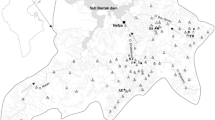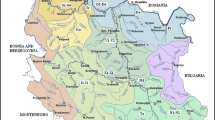Abstract
The Farmington River, located in the northeastern USA, originates from Massachusetts and flows through several towns until it joins the Connecticut River in Windsor, Connecticut. Trace element concentrations within the drainage systems of the Farmington River are a growing concern, largely due to the presence of both historical and present land use activities along the river that include mining, farming, urbanization, industrialization, landfills, and shooting gun ranges. This study examined the impact of land use activities and geology on the chemical signature of major and trace elements within the Farmington River. A total of seventy-eight (78) stream sediment and corresponding water samples were collected and analyzed for twenty-one chemical elements (As, Be, Ca, Cd, Co, Cr, Cu, Fe, Li, Mg, Mn, Mo, Ni, Pb, Sb, Se, Sr, Ti, Tl, V, and Zn) and basic river sediment parameters such as particle size distribution and organic matter contents. Results showed spatial variability in the concentration of elements along the river flow path, with the highest concentrations of As, Cd, Ni, Zn, and Pb determined at location FR31 due to various human activities within the surrounding environment. However, most sampling locations do not pose a major environmental concern. Multivariate statistical analysis showed inter-relationship among most elements, with a weak but significant positive relationship with fine particle sizes in sediment. Results of principal component analysis (PCA) suggested a combination of both geogenic and anthropogenic sources of trace elements to the Farmington River system.




Similar content being viewed by others
Data availability
Summary statistics of data is provided; further inquiries can be directed to the corresponding author.
References
Ayari, J., Agnan, Y., & Charef, A. (2016). Spatial assessment and source identification of trace metal pollution in stream sediments of Oued El Maadene basin, northern. Tunisia: Environmental Monitoring and Assessment, 188(7):397.
Boës, X., Rydberg, J., Martinez-Cortizas, A., Bindler, R., & Renberg, I. (2011). Evaluation of conservative lithogenic elements (Ti, Zr, Al, and Rb) to study anthropogenic element enrichments in lake sediments. Journal of Paleolimnology, 46(1), 75–87.
Charriau, A., Lesven, L., Gao, Y., Leermakers, M., Baeyens, W., Ouddane, B., & Billon, G. (2011). Trace metal behaviour in riverine sediments: Role of organic matter and sulfides. Applied Geochemistry, 26(1), 80–90.
Clarke, B. O., Anumol, T., Barlaz, M., & Snyder, S. A. (2015). Investigating landfill leachate as a source of trace organic pollutants. Chemosphere, 127, 269–275.
da Silva, Y. J. A. B., Cantalice, J. R. B., do Nascimento, C. W. A., Singh, V. P., da Silva, Y. J. A. B., Silva, C. M. C. A. C., de Oliveira Silva, M., & Guerra, S. M. (2017). Bedload as an indicator of heavy metal contamination in a Brazilian anthropized watershed. Catena, 153, 106–113.
Dane, J. P., & Topp, G. C. (2002). Method of soil analysis. Part 4: Physical Methods, Soil Science Society of America, Madison, Wisconsin. 1–169.
Dean, W. E. (1974). Determination of carbonate and organic matter in calcareous sediments and sedimentary rocks by loss on ignition; comparison with other methods. Journal of Sedimentary Research, 44(1), 242–248.
DEEP. (2012). Farmington River Watershed Summary: https://www.ct.gov/deep/lib/deep/water/tmdl/statewidebacteria/farmingtonriver4300.pdf
Díaz-de Alba, M., Galindo-Riano, M., Casanueva-Marenco, M., García-Vargas, M., & Kosore, C. (2011). Assessment of the metal pollution, potential toxicity and speciation of sediment from Algeciras Bay (South of Spain) using chemometric tools. Journal of Hazardous Materials, 190(1–3), 177–187.
DPH. (2020). Connecticut Department of Public Health. https://portal.ct.gov/DPH/Press-Room/Press-Releases---2020/DPH-Updates-Advisory-for-Fish-Caught-In-Farmington-River
Duong, T. T. T., & Lee, B. K. (2011). Determining contamination level of heavy metals in road dust from busy traffic areas with different characteristics. Journal of Environmental Management, 92(3), 554–562.
Gao, J., Tian, H., Cheng, K., Lu, L., Wang, Y., Wu, Y., Zhu, C., Liu, K., Zhou, J., Liu, X., Chen, J., & Hao, J. (2014). Seasonal and spatial variation of trace elements in multi-size airborne particulate matters of Beijing, China: Mass concentration, enrichment characteristics, source apportionment, chemical speciation and bioavailability. Atmospheric Environment, 99, 257–265.
Gardner, K. M., & Royer, T. V. (2010). Effect of road salt application on seasonal chloride concentrations and toxicity in south-central Indiana streams. Journal of Environmental Quality, 39(3), 1036–1042.
Ghrefat, H. A., Abu-Rukah, Y., & Rosen, M. A. (2011). Application of geoaccumulation index and enrichment factor for assessing metal contamination in the sediments of Kafrain Dam, Jordan. Environmental Monitoring and Assessment, 178(1–4), 95–109.
Jain, C., Singhal, D., & Sharma, M. (2005). Metal pollution assessment of sediment and water in the river Hindon, India. Environmental Monitoring and Assessment, 105(1), 193–207.
Jiao, W., Chen, W., Chang, A. C., & Page, A. L. (2012). Environmental risks of trace elements associated with long-term phosphate fertilizers applications: A review: Environmental Pollution, 168, 44–53.
Kaiser, H. F. (1974). An Index of Factorial Simplicity: Psychometrika, 39(1), 31–36.
Kang, X., Song, J., Yuan, H., Duan, L., Li, X., Li, N., Liang, X., & Qu, B. (2017). Speciation of heavy metals in different grain sizes of Jiaozhou Bay sediments: Bioavailability, ecological risk assessment and source analysis on a centennial timescale. Ecotoxicology and Environmental Safety, 143, 296–306.
Lord, M. L., Germanoski, D., & Allmendinger, N. E. (2009). Fluvial geomorphology: Monitoring stream systems in response to a changing environment. Geological Monitoring, 69–103.
Loska, K. (2004). Metal contamination of farming soils affected by industry. Environment International, 30(2), 159.
Ma, L. Q., Cao, R. X., Hardison, D., Chen, M., Harris, W. G., & Sartain, J. (2002). Environmental impacts of lead pellets at shooting ranges and arsenical herbicides on golf courses in Florida. Florida center for solid and hazardous waste management report, 02–01.
MacDonald, D. D., Ingersoll, C. G., & Berger, T. (2000). Development and evaluation of consensus-based sediment quality guidelines for freshwater ecosystems. Archives of Environmental Contamination and Toxicology, 39(1), 20–31.
Nordstrom, D. K. (2011). Hydrogeochemical processes governing the origin, transport and fate of major and trace elements from mine wastes and mineralized rock to surface waters. Applied Geochemistry, 26(11), 1777–1791.
Nriagu, J. O. (1979). Global inventory of natural and anthropogenic emissions of trace metals to the atmosphere. Nature, 279(5712), 409–411.
Nriagu, J. O., & Pacyna, J. M. (1988). Quantitative assessment of worldwide contamination of air, water and soils by trace metals. Nature, 333(6169), 134–139.
Oyewumi, O., Feldman, J., & Gourley, J. R. (2017). Evaluating stream sediment chemistry within an agricultural catchment of Lebanon. Northeastern USA: Environmental Monitoring and Assessment, 189(4), 141.
Oyewumi, O., & Schreiber, M. E. (2012). Release of arsenic and other trace elements from poultry litter: Insights from a field experiment on the Delmarva Peninsula, Delaware. Applied Geochemistry, 27(10), 1979–1990.
Oyewumi, O., Schreiber, M. E., & Ciparis, S. (2014). The impact of poultry litter application on sediment chemistry of the Broadkill River estuary system, Delaware. Environmental Monitoring and Assessment, 186(1), 97–115.
Pandey, M., Tripathi, S., Pandey, A. K., & Tripathi, B. D. (2014). Risk assessment of metal species in sediments of the river Ganga. CATENA, 122, 140–149.
Raju, K. V., Somashekar, R., & Prakash, K. (2012). Heavy metal status of sediment in river Cauvery, Karnataka. Environmental Monitoring and Assessment, 184(1), 361–373.
Roberts, T. L. (2014). Cadmium and phosphorous fertilizers: The issues and the science. Procedia Engineering, 83, 52–59.
Robinson, G. R., & Ayuso, R. A. (2004). Use of spatial statistics and isotopic tracers to measure the influence of arsenical pesticide use on stream sediment chemistry in New England, USA. Applied Geochemistry, 19(7), 1097–1110.
Ruhl, L., Vengosh, A., Dwyer, G. S., Hsu-Kim, H., Deonarine, A., Bergin, M., & Kravchenko, J. (2009). Survey of the potential environmental and health impacts in the immediate aftermath of the coal ash spill in Kingston, Tennessee. Environmental Science & Technology, 43(16), 6326–6333.
Salati, S., & Moore, F. (2010). Assessment of heavy metal concentration in the Khoshk River water and sediment. Shiraz, Southwest Iran: Environmental Monitoring and Assessment, 164(1), 677–689.
Shaheen, S. M., Tsadilas, C. D., and Rinklebe, J. (2013). A review of the distribution coefficients of trace elements in soils: Influence of sorption system, element characteristics, and soil colloidal properties. Advances in Colloid and Interface Science, 201–202, 43–56.
Siddiqui, E., & Pandey, J. (2019). Assessment of heavy metal pollution in water and surface sediment and evaluation of ecological risks associated with sediment contamination in the Ganga River: A basin-scale study. Environmental Science and Pollution Research, 26(11), 10926–10940.
Skerfving, S., Löfmark, L., Lundh, T., Mikoczy, Z., & Strömberg, U. (2015). Late effects of low blood lead concentrations in children on school performance and cognitive functions: NeuroToxicology.
Skoulikidis, N. T., Gritzalis, K. C., Kouvarda, T., & Buffagni, A. (2004). The development of an ecological quality assessment and classification system for Greek running waters based on benthic macroinvertebrates, Integrated Assessment of Running Waters in Europe, Springer, p. 149–160.
Sloan, J. J., Dowdy, R. H., Dolan, M. S., & Linden, D. R. (1998). Long-term effects of biosolids applications on heavy metal bioavailability in agricultural soils. Journal of Environmental Quality, 26(4), 966–974.
Sparks, D. L. (2003). Environmental soil chemistry. Elsevier.
Suresh, G., Sutharsan, P., Ramasamy, V., & Venkatachalapathy, R. (2012). Assessment of spatial distribution and potential ecological risk of the heavy metals in relation to granulometric contents of Veeranam lake sediments, India. Ecotoxicology and Environmental Safety, 84, 117–124.
Sutherland, R. A. (2000). Bed sediment-associated trace metals in an urban stream. Oahu, Hawaii: Environmental Geology, 39(6), 611–627.
Szabo, Z., Buro, B., Szabo, J., Toth, C. A., Baranyai, E., Herman, P., Prokisch, J., Tomor, T., & Szabo, S. (2020). Geomorphology as a driver of heavy metal accumulation patterns in a floodplain. Water, 12(2), 563.
Turekian, K. K., & Wedepohl, K. H. (1961). Distribution of the elements in some major units of the earth’s crust. Geological Society of America Bulletin, 72(2), 175–192.
Vantelon, D., Lanzirotti, A., Scheinost, A. C., & Kretzschmar, R. (2005). Spatial distribution and speciation of lead around corroding bullets in a shooting range soil studied by micro-X-ray fluorescence and absorption spectroscopy. Environmental Science & Technology, 39(13), 4808–4815.
Viers, J., Dupré, B., & Gaillardet, J. (2009). Chemical composition of suspended sediments in World Rivers: New insights from a new database. Science of the Total Environment, 407(2), 853–868.
Vijver, M. G., Spijker, J., Vink, J. P. M., & Posthuma, L. (2008). Determining metal origins and availability in fluvial deposits by analysis of geochemical baselines and solid-solution partitioning measurements and modelling. Environmental Pollution, 156(3), 832–839.
Wu, J., Li, P., Qian, H., Duan, Z., & Zhang, X. (2014). Using correlation and multivariate statistical analysis to identify hydrogeochemical processes affecting the major ion chemistry of waters: A case study in Laoheba phosphorite mine in Sichuan, China. Arabian Journal of Geosciences, 7(10), 3973–3982.
Yan, N., Liu, W., Xie, H., Gao, L., Han, Y., Wang, M., & Li, H. (2016). Distribution and assessment of heavy metals in the surface sediment of Yellow River, China. Journal of Environmental Sciences, 39, 45–51.
Yaşar, D., Aksu, A. E., & Uslu, O. (2001). Anthropogenic pollution in Izmit Bay: Heavy metal concentrations in surface sediments. Turkish Journal of Engineering and Environmental Sciences, 25(4), 299–313.
Zoumis, T., Schmidt, A., Grigorova, L., & Calmano, W. (2001). Contaminants in Sediments: Remobilisation and Demobilisation: Science of the Total Environment, 266(1–3), 195–202.
Acknowledgements
We appreciate Dr. Denise Levitan for her useful comments and revision of the initial manuscript. We are equally grateful for the support of Drs. Evans, Piatek, and Wizevich of the CCSU Geological department.
Funding
This research work was funded by the CCSU-AAUP and CCSU Faculty-Student Research grants.
Author information
Authors and Affiliations
Corresponding author
Ethics declarations
Conflict of interest
Not applicable.
Additional information
Publisher's Note
Springer Nature remains neutral with regard to jurisdictional claims in published maps and institutional affiliations.
Highlights
• Sediments and corresponding water chemistry were influenced by the flow rates, river gradients, and geomorphology.
• Only few locations have extremely high sediment enrichments with respect to As, Cd, Ni, Zn, and Pb.
• Ecological assessment showed mostly insignificant risks for benthic organisms.
• Principal component analysis showed a combined influence of geogenic and anthropogenic factors on trace element concentrations.
Supplementary information
Below is the link to the electronic supplementary material.
Rights and permissions
About this article
Cite this article
Oyewumi, O., Cavanaugh, C., Guzzardi, D. et al. Geochemical assessment of trace element concentrations in the Farmington River, Connecticut, Northeastern, USA. Environ Monit Assess 194, 345 (2022). https://doi.org/10.1007/s10661-022-10013-y
Received:
Accepted:
Published:
DOI: https://doi.org/10.1007/s10661-022-10013-y




